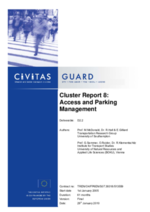Installing electronic controls for the Mestre restricted access zone
Summary
Introducing a congestion charge in order to reduce access to Mestre, on the Venice mainland, contributed to lowering atmospheric and noise pollution.
Implementing sustainable mobility
Prior to CIVITAS MOBILIS, heavy vehicular traffic on the Venice mainland, and in Mestre in particular, was one of the most pressing urban transportation issues. The increase in traffic had brought about an increase in environmental pollution as well as congestion problems.
According to data from the Regional Agency for the Environment (ARPAV), urgent initiatives were needed to reduce atmospheric pollution. In 2003, atmospheric pollution limit values were exceeded on 111 days and the trend continued in 2004: at the beginning of the year the limit values had already been exceeded 49 times. The demand for access to the city area remained very high: the volume of traffic increased by between 8 and 13 percent between 2000 and 2004 and the trend was forecast to continue. The city had already applied traffic regulation measures such as traffic rationing schemes based on licence plate numbers; car-free Sundays; and the “Blue Sticker” scheme for controlling exhaust emissions. However, there was no automatic system for enforcing the regulations on access for cars with odd and even licence plates on alternate days, nor had the mainland area of Venice ever previously applied road pricing initiatives such as congestion charging.
Progress
The measure was planned in three phases:
- the identification of the best locations for the electronic access control points;
- the installation and testing of telecameras and other technologies to monitor compliance with the control access regulations; and
- a feasibility study to analyse the possibility of introducing a congestion charge in the Venice mainland urban centre.
Following the installation of the data transmission network and 12 telecameras, the software was modified so that the Venice local authority could use the data in the context of the “alternate number plate” initiative. The City of Venice and ASM, the manager of all urban mobility services and car parks at city level, developed the web interface to allow for the automatic registration of vehicles eligible for special passes to travel in Mestre (e.g. doctors, public transport vehicles, car-sharing cars and emergency services). When the system cannot automatically read a licence plate, an operator controls the system on a photo-by-photo basis.
An awareness-raising campaign took place, with the dissemination of leaflets to inform citizens about the installation of telecameras and about the new traffic restrictions. The brochure highlighted alternatives such as interchange car parks, car sharing and bike rental in order to encourage a shift in favour of more sustainable transport modes.
The Mobility Department of the City of Venice delivered the feasibility study on congestion charging in April 2008. The document explores how a potential road pricing policy for Mestre could be developed and its potential effects.
Outcomes
The target of a 10 percent reduction in the number of cars entering the city had been fully achieved by 2008. Between 2005 and 2008, after the installation of telecamera control, a decrease was noticed during peak hours: by about 7.5 percent between 07:00 and 08:00 and 8.1 percent between 08:00 and 09:00; and by about 11 percent between 17:00 and 18:00 and over 13.5 percent between 18:00 and 19:00. Between 2005 and 2008, the total decrease in the volume of vehicles was 9.88 percent.
The environmental impact in terms of congestion and pollutant emissions was not measure during the MOBILIS project period due to a lack of relevant data.








